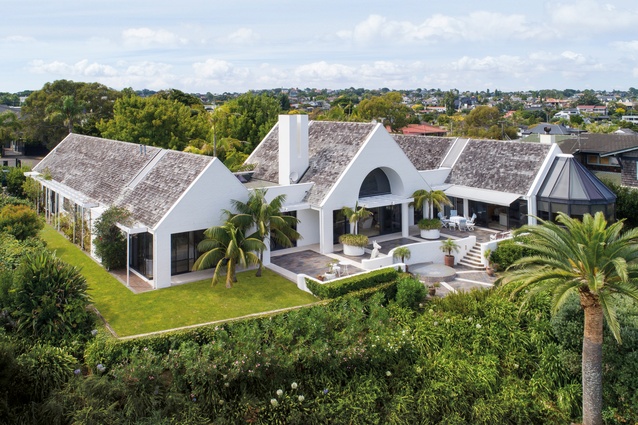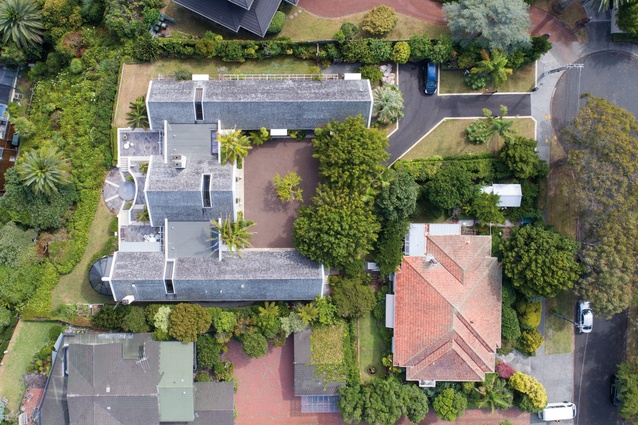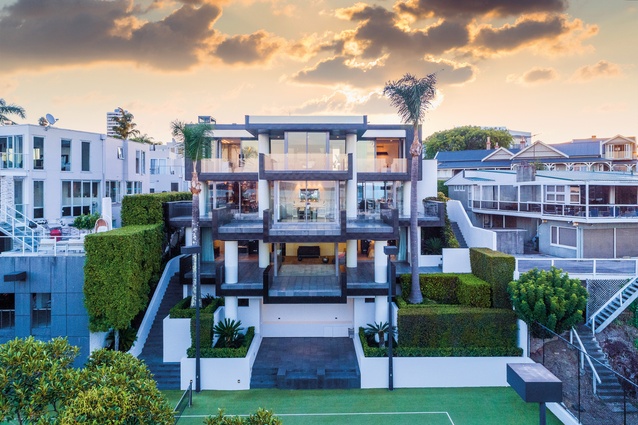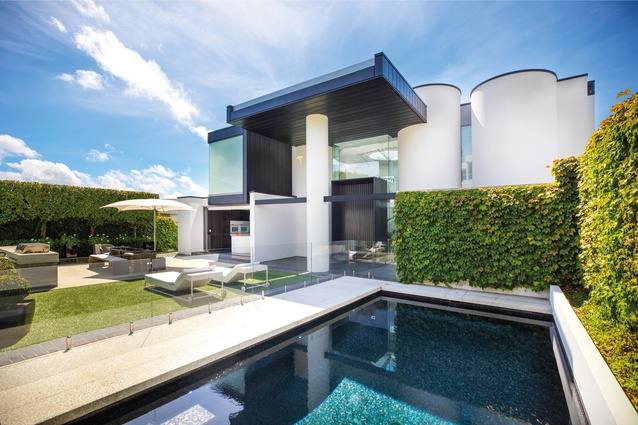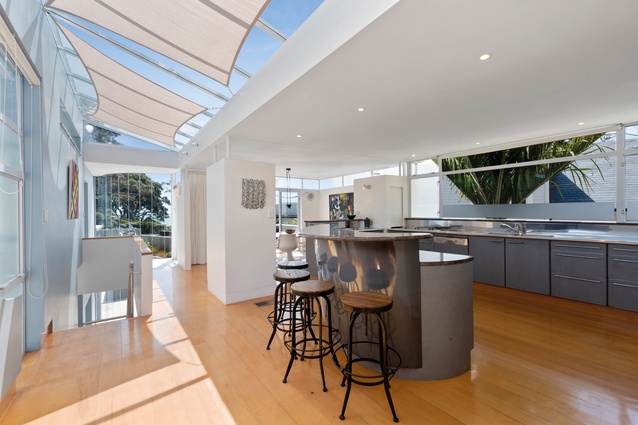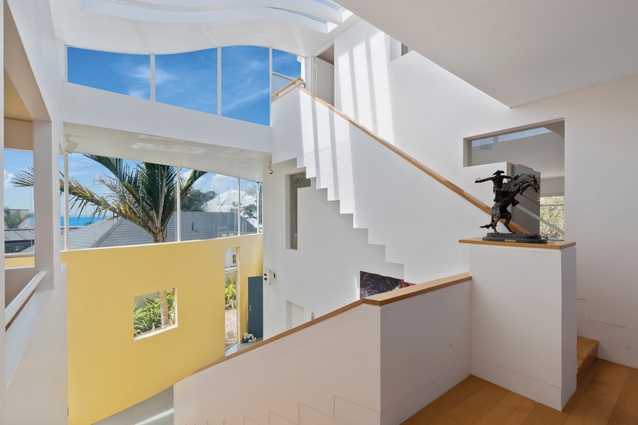Once more, with feeling
Chad McMan and Giles Reid step back in time to the 1980s and the era of PoMo – pastels, neon and odd nods to classical forms – that cause some architects to shudder. Others say it’s worth a second look.
“The 1980s saw New Zealand architects embrace postmodern architecture with its historical references, decoration, metaphors and overall glamour and glitz – which were intended to be sophisticated, but to modernist eyes appeared superficial. Auckland architects responded with enthusiasm.”1
Postmodernism’s reassessment is on the rise, the return of the return. Buildings such as John Outram’s Isle of Dogs Pumping Station (1986-88) and Stirling Wilford’s No. 1 Poultry (1992-97) have been listed by Historic England. Postmodernism is sweeping back through the architecture schools due to Europe’s new wave of ironists including Fala (Portugal), KGDvS (Belgium) and Lütjens Padmanabhan (Switzerland). The critical re-examination of Denise Scott Brown and Robert Venturi was turning into something of a publishing industry even before Venturi’s death in late 2018.
This reassessment will fill New Zealand architects with mild dread. The past 30 years have been a collective process of burying the 1980s, a transformative period which at the time was seen as one of energy, growing up and leaving behind the economic depression of the 1970s but is now almost universally dismissed as a moment of national naivety.
For New Zealand in particular, postmodern architecture is bound up with the image of the rendered building. Then, it signalled an ‘internationalist outlook’ and a ‘Mediterranean lifestyle’. Now, it screams shoddy design and construction, legal action and crippling recladding costs. This scandal has created a trail of defective and demolished buildings from which eighties Architecture (capital ‘A’) has been anything but immune.
However, as New Zealand’s embrace of the 1950s wanes and its rediscovery of the 1960s and 1970s gathers pace, it would be logical for the 1980s to come next. In February of this year, three notable houses from the 1980s, completely forgotten today, came up for sale on Trade Me: Robert Paterson’s Allen House at 14 Aumoe Avenue, Kohimaramara (1982); Malcolm Hislop’s Lewis House at 81b Shelly Beach Road, St Marys Bay (1988) and Miriam White’s house for her parents, 14 Brett Avenue, Takapuna (1988-92). This piece comes out of that small coincidence and hopes to tease out some of the ideas and interactions from that period.
Robert Paterson
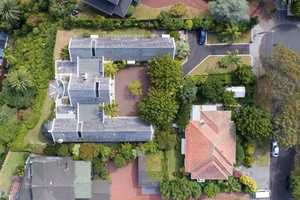
Robert Paterson (1945-89) was one of Auckland’s finest architects of the 1980s. Today, he is solely remembered for the Doug Walsh House, or ‘Mirror House’ as it was known, in Minnehaha Avenue, Thorne Bay, Takapuna, 1982. Originally its seafront elevations were clad entirely in faceted mirror glass, allowing views out but denying anything back. David Mitchell called it “utterly compelling and downright foreign … captivating, but like the sunglasses on a face, they give nothing away …The house appears as a vast stage set for a play that we plebeians can only guess at.”2 Around 2000 it was given a facelift with clear bolt-fixed glass, destroying its key idea.
Paterson graduated alongside Simon Carnachan at Auckland University in 1974, with whom he remained friends. From 1972-74 he worked at Warren and Mahoney in Christchurch before returning to Auckland to work with Claude Megson from 1974 to 1975. Megson rated Paterson highly, saying that he “could draw like an angel”.3
Paterson joined Robert Railley and David Swan in 1975 where he assumed the role of design architect, leaving in 1985 to establish his own practice. Swan was recognised for his skilful traditional detailing to older houses. Railley focused on interiors and the firm’s administration.
Paterson’s disappearance can be attributed to many things. Firstly, his client base was often wealthy and conservative, with little appetite for publicity. Secondly, he adopted a low profile as a gay man well before the passing of the 1986 Homosexual Law Reform Act and moved in circles very different from the clubbish profession. Thirdly, he was struck down with illness and died in his early forties. Finally, his work is impossible to categorise. His designs span a huge range stretching from Arts and Crafts, to classical to modern. Eclecticism is today a pejorative but Paterson’s houses are done with a level of conviction, scholarship and attention to detail which far surpassed most of his contemporaries working exclusively in similar idioms.
Swan Railley Paterson made their biggest mark with large houses for the well-heeled. However, they also made a notable commercial impact, remodelling Queens Arcade (1982) by removing the top storeys, introducing a continuous rooflight, polished marble shop fronts, indoor fountain and glass-sided escalators leading to a mezzanine with restaurant overlooking Queen Street. The project was a key early work in the still ongoing transformation of Queen Street from strip road towards a more layered CBD.4
Paterson’s early houses such as the Fillmore House, Burtt Road, Pukekohe (1980) show Megson’s influence, for example the Donovan House, Whitford (1976). However the forms, rather than being knotted together, are marked by a precise silhouette. In Paterson’s work, volumes remain distinct.
His best Arts and Crafts work is the alteration to the Hellaby House for David and Libby Richwhite, Remuera Road (1985-88).5 The original building was by Roy Binney (1885-1957), who worked for Edwin Lutyens (1869-1944). Paterson’s additions are a clear homage to Lutyens’ Deanery, Sonning, Berkshire (1899-1901), adding a double-height family room, pool, terraces, gardens and tennis pavilion.
His most noted classical building was the Aigner House (more commonly called ‘Mirabell’), Patumahoe (1987)6 a grand French chateau in the countryside. Other Palladian-inspired houses include the Glucina House,West Coast Road, Oratia (1983) and the Colvin House (‘Earlston’), Glenbrook Road, Karaka (1988).
Paterson’s postmodern and late-modern work is closer to contemporary sensibilities. Among his very best are the Stevenson House in Cockle Bay (1989) and the Souter House, Shelly Beach Road, Westhaven (1988).7 Today the Souter House is painted grey but was then white, yellow and ochre in the manner of early Robert Stern and featured an interior reminiscent of Hans Hollein’s marbled and palm treed shop fit-outs in Vienna.
Contemporary with Black Rock is the Woodroffe House, Seacliffe Avenue, Belmont (c.1988), near Pip Cheshire’s Congreve House. The sea-facing elevation is a mirror clad inverted ‘T’ (shades of Rewi Thompson). The other elevations are Pompeian red paint on render. The interior features terracotta-tiled floors, glass block walls, Harry Seidler-esque curving balconies and stainless steel tubular railing. It deserves to be far better known.
The house for Maurice and Beverley Allen8 at Aumoe Avenue, Kohimaramara (1982) was designed when the sands were already shifting from postmodernism to an architecture less pre-loaded with symbolism.9 The house was prominently featured in Australian House and Garden’s ’New Zealand Now’ issue, January 1984, alongside the Trellis House by Mal Bartleet (of Artifice). It was also included in Marilyn Reynold’s and Stephanie Bonny’s book New Zealand Houses Today (1988) under the heading, ‘Imposing House for an Art Collector’.10
Its massing is toy-like. Pyramids are stacked atop cubes. Gable-roofed volumes are separated by flat roof gaskets. The garage is housed in one wing and bedrooms in the other, together framing an entrance courtyard leading to the front door and beyond to the living area. Windows are extruded back from the white building face. Double chimneys leave a void between each stack when seen against the sky. Internal volumes are modelled like Styrofoam cut through with hot wire.
The Allen House exemplifies geometric purity rigorously executed at every scale. The bagged-brick exterior accentuates the surface and planar aesthetics. Columns have neither capitals nor bases. The geometries used are ‘perfect’: the square (suspended grid-like pergolas), the triangle (roof gables) and the circle or half circle (window openings, spa pool, low-level terrace columns, wall-mounted external lights, freestanding terrace planters etc.).
By contrast, the cedar shingle roof hints at something more vernacular. Rooflight glazing is sliced into the roof plane in a near-identical way to Simon and Robyn Carnachan’s house at Melford Street, St Marys Bay (1982); a really taut piece of Megson planning, but more relaxed, with beautiful steelwork and better guttering, now much altered internally and minus the Kazuo Shinohara cross-braced carport.
Proud detailing is suppressed to accentuate the purity of line. Walls are white, as are gutters and downpipes. There are no verges or eaves, and slimline flashings are painted out. The roof plane is set flush with the top of the gable ends to accentuate their planar quality, with a small raking gutter set between the plastered parapet and the shingles – a detail also familiar from Megson’s houses.
The ceiling plane is kept free of light fittings which are generally concealed. The detailing of architraves and fireplace hearth and mantle mirrors the geometry of the house. Abstracted classical references abound. There is something proto-Apple-aesthetic in the smooth, seamless, ‘perfect’ plastic geometries and the house is futuristic in an early 1980s Japanese-tech way – as in Takefumi Aida’s Toy Block House series from 1974 onwards.
The architecture’s futurism was underscored with its central casting in The Quiet Earth, Geoff Murphy’s 1985 disaster-dystopian film in which a man (Bruno Lawrence) wakes up to find Auckland devoid of all life; sci-fi as satire. Its overscaled elements recall a ruin, a grand structure stripped bare by decades of sun and wind, a structure from another time.
Paterson’s Allen House in particular and Carnachan’s work more generally show the studied appreciation of North American architect Hugh Newell Jacobsen. Jacobsen delivered the Kennedy Memorial Fellowship lectures at four New Zealand universities in 1971.11 Like the Allen House, a huge number of Jacobsen’s plans adopt the classic ‘E’ (or ‘H’) configuration.12 Works such as the Dreier-Barton House (Four Linked Pavilions), Washington DC (1976-77) or the Putterman Residence, Carlisle, Pennsylvania (1982) are obvious precursors to work in New Zealand during the 1970s and 1980s.
Malcolm Hislop
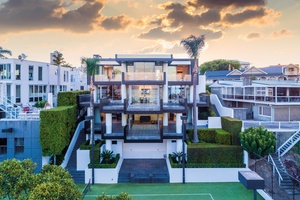
Malcolm Hislop was ex-Warren and Mahoney Christchurch, apprenticing to them in their heyday. He later acted as lieutenant to the brilliant and massively overlooked Neville Price during his peak career in New Zealand, so was familiar with his best works. He carried on some existing projects when Price departed for America in 1980. Unsurprisingly then, his work is heavily influenced by Price and characterised by the jet-set international styles of American Palm Springs modernism, which was morphing into postmodernism at the time of Price’s departure.
Hislop’s work is characterised by an emphasis on sculptural modelling of surface and form. Buildings read as three-dimensional expressions of the plan diagram, with strong uncompromised ideas that arrange living patterns in a carefully considered way. A concentration of Hislop’s buildings overlook Westhaven Marina: Nos. 17 (1 and 2) and 19 Ring Terrace, off Shelly Beach Road, published in October 1987 at the precise moment of the stock market crash,13 103 Shelly Beach Road (c.1987, one down from Paterson’s Souter House, whose working drawings were done by Hislop) and the Lewis development at 81a and 81b Shelly Beach Road (1988).14
The Lewis development comprises two substantial houses on a prominent site, with a speculative house sitting behind a larger house on the clifftop. An exuberant fantasia of three-dimensional forms, they were serious pieces of architecture when built. Twenty years on 81b was repurposed as neo-modernism, showing how fashion changes and history is consciously overwritten. Regardless of the remodelling, the house is strong enough for the original design to still be seen peering out from underneath.
The design emphasises solid and void, with glazing floor to ceiling, wall to wall. It consciously eschews sashes or transoms, leaving large plate glass as openings set within wall planes, suppressing the delineation of inside and out. The columns originally had concentric rings expanding up and out, having no functional purpose but reading as vestigial capitals. These details, now unpopular, were removed when the house was remodelled and newer 1960s Harry Seidler-esque ‘tray’ balconies added.
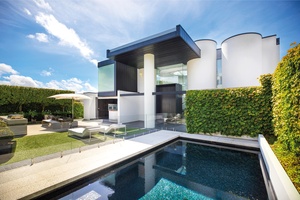
The design didn’t stop at the building envelope but consumed the entire site. The programme is broken into functions and a form attributed to each, in the manner of, say, Athfield or Roger Walker in the 1970s, but transformed here into circular forms rather than square. Internally the house revolves around a semicircular stairwell and void linking all levels, with different functions accommodated within separate geometric forms. Outside, the guest changing room, pump room, and spa pool are all extruded cylinders and read (or would have read) as an extension of the fluid internal spaces.
The recurring form of the circle, the strong interpenetration of horizontals and verticals, and a building made of plates and tubes recall the work American architect, Paul Rudolph – overt, present, and powerful – for example his Wallace House, Athens, Alabama (1961-64) with a giant order of 32 columns harking back to the Greek Southern antebellum style. In Hislop’s work, skylights, columns, chrome handrails, expressed chimney flues, and entire rooms for that matter are expressed as extruded cylinders, knitted together in a three-dimensional grid.
Aspects of the floor plan show ziggurat patterning of wall planes, a motif repeated in the stepped banding of roof forms including some glazing. The ziggurat is closely aligned with postmodernism as a movement, specifically Memphis design. The original colours of both houses were characteristically eighties; a bold apricot hue, with the larger house later painted peppermint green with purple and blue highlights.
In elevation the larger house is (almost) exclusively composed of two materials, plaster and glass. Like the work of Athfield and Price in the seventies, plaster was able to cover rough workmanship and give a uniform finish that accentuated surface and shape; the main Lewis House, while substantial, appears quite weightless relative to its size.Wall planes are notable for their radiused edges top and bottom with no expressed driplines, as though wall elements were formed and vacuum sealed as perfectly shaped elements composed and suspended in space.
Miriam White
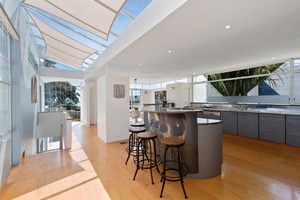
Miriam White (b.1964) started design on her parents’ house at 14 Brett Avenue in Takapuna when she was 23.15 Design started in 1988 and construction finished in 1992. At the same time, she was working for Jack Manning and David Mitchell as project architect on the Alan and Jenny Gibbs’ House on Paratai Drive, taking up the role performed earlier by Noel Lane on Gibbs I, Judges Bay. She left to work in Hong Kong with Foster and Partners on Chek Lap Kok airport in 1995 before moving to London where she has worked since.
The language of White’s house shares much in common with Manning Mitchell’s School of Music (1986): big cyma recta double-curving walls and optimistic pastel colours. Robert Stern’s Lang House (1973-74) and Ehrman House (1974-76) were big influences on the plan, as indeed they were on many other Auckland houses of the time, for example Architectus’ house at Cliff Road, Torbay (1986)16 and their house at Clive Road, Epsom, (1987)17. Floating above this and so many houses of the period is the lifestyle dream of Arquitectonica’s Spear House, Biscayne Bay, Miami Beach (1977).
The building is aligned with the long diagonal of the plot. Its interior reaches out to the boundaries. The edict to ‘cover the site’, most associated with Claude Megson, is curiously also found in Manning Mitchell’s (and Stout’s) work and also here in White’s. Cubes for shelter and functional elements of the programme are arranged along the axes. Circulation and light flow between. Entry is alongside the garage before sweeping up to the first-floor living room. The dining, kitchen and main bedroom are also on this level. Guest and children’s bedrooms occupy the ground floor.
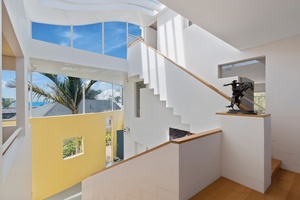
Roofs are pulled apart from walls and walls from each other, which under the Auckland sun creates an interior nearly indistinguishable from the outside, except that the blade walls shield views into the site. This deconstruction of the box can also clearly be seen in David Mitchell and Julie Stout’s Baragwanath House, Taurarua Terrace, Parnell (1987), which White was left in sole charge of after Mitchell and Stout departed on their first Pacific voyage.
Bathrooms and kitchen and indeed the house as a whole survive in completely original and mint condition, probably only the case when parents are charged with maintaining their daughter’s vision. As with so many houses of the time, it adopted render on timber-frame construction.
But unlike the many buildings that followed, White and her generation were trained rigorously in construction by Ivan Mercep of JASMaD under the old NZCAD system at Carrington Polytechnic – render on chicken wire on beer-bottle tops on building paper on, in this case, three layers of marine ply. The acoustics of the house lead one to believe it is made of concrete block, it feels so solid.
Conclusion
Looking back is, of course, an exercise in deciding what to keep or discard. However, there is a very strong tendency in New Zealand to whitewash over the 1980s, regarding the era as simply an error. Some key examples illustrate this.
Manning Mitchell’s Gibbs I featured on the cover of David Mitchell’s The Elegant Shed, 1984 (first a television series then a book). It brought the practice to national prominence and remains a cornerstone of their oeuvre. In its mixing of high art and low, cheap and glossy construction, it felt like a continuation of their earlier low-cost housing and education work.
Gibbs II, by contrast, supervised by Miriam White and the more prominent and polished work (as in little expense spared), is harder to place and has been conveniently overlooked. Compare its treatment with the detailed critique and continued praise afforded Mitchell Stout’s own house in Heke Street (1990), completed one year prior to Gibbs II. The seemingly massive distance travelled between the two remains completely undiscussed.
Jasmax’s website does provide some mention of their original incarnation as JASMaD but shows none of their works. This is difficult to understand. The founding practice produced a strong body of humanist work which has stood up well over time. Samoa House/Maota Samoa, Karangahape Road (1978) for instance has many interesting things to say about biculturalism.
Warren and Mahoney are even more ruthless. The only building listed on their website between 1977 and 1990 is the Michael Fowler Centre, Wellington (1975-1983). Gone are all their postmodern towers, significant works at the time, including The Wellington Club and 88 The Terrace (1985-89), 49 Boulcott Street, Wellington (1986-89), and 23 Customs Street (Citibank Building), Auckland (1987-89).Missing is Royal Oak Shopping Mall (1984-88) and Rotorua Civic Centre (1982-85). Incomprehensible is the absence of Washington Chancery (1974-79) which included Robert Paterson on the project team and is a building that Warren himself considered amongst the practice’s very best.18 For the black sheep archive, you have to hunt down a copy of their 1989 monograph.
Missing from the website is every one of their houses of the period; the Nathan House, Combes Road (1979-81), described as “the partnership’s first postmodern neo-classic form”19 and the Mulholland House, Mangamahu Valley, (1990).[20] Naturally absent is their colossal house for Doug Myers, 220 Victoria Avenue (1990; this at least is a style unlikely to be revived any time soon). 20
The practice’s transition from Sir Miles Warren and Maurice Mahoney’s concrete beam and block buildings, which the website is rightly proud of, through their representational work of the 1980s to their output of today, is left entirely unexplained. This is work without backstory. Neo-modernism, it seems, must kill the father in order to spring from nowhere.
The internet acts as a digital echo chamber. Architects who practised before 1995 or fell out of vogue after often end up a marginal online presence at best. The closure this year of Auckland University’s architecture library, the dispersal of its physical collection and the move to online research has significant implications for the future research of the country’s ‘analogue architects’. Sir Ian Athfield’s Wellington Central Library (1988-91) could easily be the next building to go. It is to be hoped that the ensuing debate will at last spark a proper re-examination of New Zealand’s eighties architecture.
1 Mitchell, David and Chaplin, Gillian. The Elegant Shed: New Zealand architecture since 1945. Auckland, Oxford University Press, 1984, page 44.
2 Architecture NZ supplement to Architecture Week, Nov/Dec 1990, written by Peter Shaw. A Paterson retrospective was organised by Marsh Cook. Paterson’s drafting skill is evident in the drawings for Megson’s Gunn House at Stanley Point (1974), Schroff House, Red Beach (1974), Michael Hill House, Whangarei (1975) and possibly the Nathan House at Achilles Point (although, according to Megson’s list of works, the house dates from earlier, in 1972).
3 Paterson also undertook the fit-out for all the Cut Above hair salon interiors, giving Auckland a slice of decadent eighties glamour – mirrors, brass and pastels amongst the maidenhair ferns. For the Takapuna branch see Home and Building, October/November, 1986, pages 37-39. For the Remuera branch, see Home and Building August/September, 1989, pages 150-151. As with the majority of Paterson’s buildings, photography was by John Pettitt.
4 Megson later produced a comprehensive landscaping scheme for the house after Paterson died which reads as a continuation of Paterson’s work.
5 Home and Building, February/March 1989, pages 16-23.
6 Style – The Lifestyle Quarterly, No.5, Spring 1990, pages 104-112. The cover’s font was self-consciously modelled on the 1980s New Zealand soap opera Gloss.
7 Prior to design, Maurice and Beverley Allen undertook a study tour of west coast American architecture from San Francisco to San Diego, including Palm Springs, Bakersfield and Pebble Beach. Many of the materials and fittings were imported as there was a paucity of alternatives available at that time; Paterson designed the lounge suite in the living room in the manner of Richard Meier whose monographs (with custom furniture details) Paterson held and referred to. (Author’s interview with Beverley Allen, 16 July 2019).
8 See, for instance, Charles Jencks’ call for an architecture both abstract and representational: Architectural Design magazine, No.53, 1983.
9 Australian House and Garden, January 1984, pages 83-85. For Mal Bartleet’s Trellis House, refer pages 86-87. Bonny, Stephanie and Reynolds, Marilyn, New Zealand Houses Today, Weldon, New Zealand, 1988. For Allen House refer pages 132-135.
10 Later, in the late seventies and while Carnachan was on an extended sabbatical from Mark Brown and Fairhead and working at Frank Gehry’s office in Venice Beach, he tried to persuade the NZIA to bring Jacobsen back to lecture at the annual conference, together with Gehry. (Author’s interview with Simon Carnachan, 4 July 2019).
11 Both architects owned books on Jacobsen. Paterson subscribed to Architectural Record, where Jacobsen’s houses were regularly published during the 1970s.
12 Home and Building, October/November, 1987, pages 106-109.
13 For 81a Shelly Beach Road, see Home and Building, August/September, 1992, pages 104-107.
14 Home and Building, June/July, 1995, pages 98-103; New Home Trends, Volume 11, No.2, pages 16-21.
15 Architectus Bowes Clifford Thompson, A4 New Zealand Architects monograph series, New Zealand Architectural Publications Trust, 2004, page 14.
16 Home and Building, August/September, 1988, pages 113-117.
17 See Foreword by Sir Miles Warren, Warren & Mahoney Architects, 1958-1989, Christchurch, self-published, 1989.
18 Op. cit. page 50. Paterson, as an ex-employee, acted as the Warren & Mahoney Auckland representative before their Auckland office was established.
19 Home and Building, August/September 1988, pages 16-23.
20 Home and Building, April/May 1990, pages 120-127.

